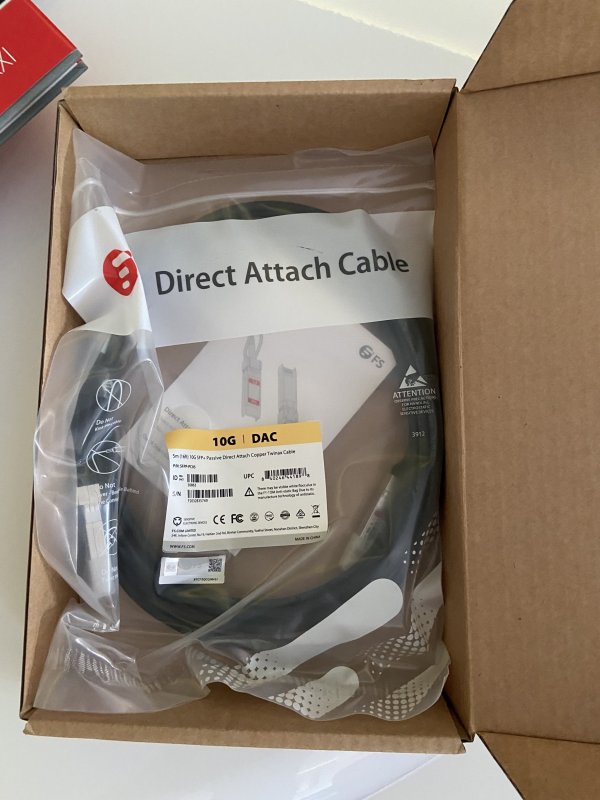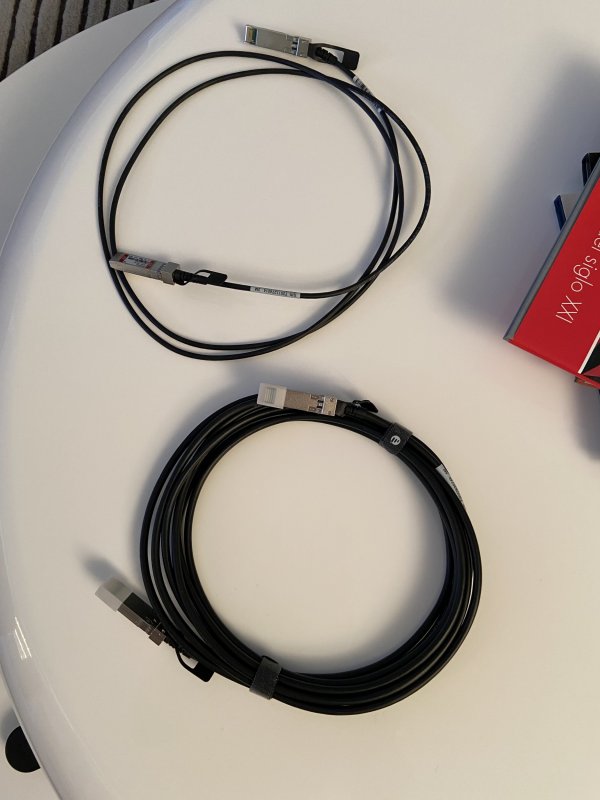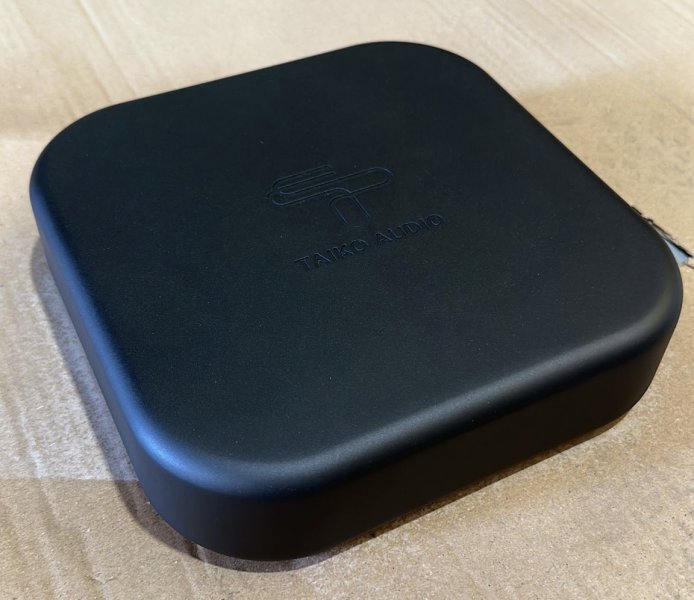Taiko Audio SGM Extreme : the Crème de la Crème
- Thread starter CKKeung
- Start date
You are using an out of date browser. It may not display this or other websites correctly.
You should upgrade or use an alternative browser.
You should upgrade or use an alternative browser.
The benefit you’re experiencing is a further reduction of the switch power consumption by switching out a RJ45 port for SFP DAC which is the dominant form of noise generation in this switch design. What happens before is much less relevant in this area.
Great news.
I believe Ether regen has also some sort of multiple isolation transformers on RJ45 ports.
This is not possible for the SFP socket.
Unfortunate etherregen is very much power hungry and gets very hot.
Taiko router should be very low with current consumption .
So Ethernet cable from home router to Taiko router and DAC cable from that To Taiko switch.
Thank you, so you think Rj45 + ethernet cable will be as good as SFP + DAC cable ?
Also I understand we could potentially
1. Replace modem by coping the settings and its mac adress .
2. Replace router by trying to mimic the router MAC address.
This is for the ultimate performance ?
For little lower performance there will be original modem and 2 routers ( original + Taiko)
as a plug and play solution?
Were you able to deeply test this 2 above scenarios ?
Would you mind to address the other questions ?
Also I understand we could potentially
1. Replace home modem by coping the settings and its mac adress .
2. Replace home router by trying to mimic the router MAC address.
This is for the ultimate performance ?
For little lower performance there will be original modem and 2 routers ( original + Taiko)
as a plug and play solution?
Were you able to deeply test this 2 above scenarios ?
Christiaan Punter
Well-Known Member
All methods you mention have indeed been tested and are basically all possible but we are currently steering toward retaining your home router and simply adding the Taiko Router downstream.Would you mind to address the other questions ?
Also I understand we could potentially
1. Replace home modem by coping the settings and its mac adress .
2. Replace home router by trying to mimic the router MAC address.
This is for the ultimate performance ?
For little lower performance there will be original modem and 2 routers ( original + Taiko)
as a plug and play solution?
Were you able to deeply test this 2 above scenarios ?
Is the reason why the router uses arm 16 cores because the better the performance, the better the sound?
Well performance matters but there’s more to it then just that. Somewhat obvious is you want low utilisation so performance is minimally impacted by WAN side traffic and traffic rules processing like port forwarding. But there’s more which went into the design of the router including the processor selection which I’m afraid I cannot disclose to avoid being prematurely copied. Prematurely being before we hit break-even on our R&D costs which might be like a year away. Disclosing this aspect of the design would take away most of the mystery surrounding the effects of ethernet networking so I’d really like to share, but in the end we do have a business to run and have to keep netting positive. I hope you understand.
Great news.
I believe Ether regen has also some sort of multiple isolation transformers on RJ45 ports.
This is not possible for the SFP socket.
Unfortunate etherregen is very much power hungry and gets very hot.
Taiko router should be very low with current consumption .
So Ethernet cable from home router to Taiko router and DAC cable from that To Taiko switch.
The router consumer 5-6 times the power of the switch.
Yes RJ45 ethernet cable from home router to Taiko router and DAC cable from Taiko router to switch is optimal. Further improved performance can be obtained by powering both Taiko router and switch from a single DC powersupply using the Taiko DC distributor. Then there’s even more to be gained by using the upcoming battery supply.
Although my system with a 1 meter DAC cable doesn't sound thin at all, testing a 5 meter cable was really cheap so it just arrived and I'm going to put it up this afternoon.But the 1m sounds so thin in my system I cant listen for longer that 30 min.
3m are ok ,but still not as neutral as I would expect.
With 5m and 7m long runs the SQ is so much better and still remaining very transparent and real.
Attachments
In the first place, when I removed the DAC cable, I realized that the one I had was 2 meters and not 1 meter as I mistakenly believed.
On the other hand, although it had already been discussed, I was surprised by the thickness of the new cable, greater than I expected.
Certainly, differences are already noticeable, although not enormous, they are two different "flavors". I am going to give the cable at least one more day and I will comment on the differences and which "flavor" I like more, which at this moment I am not clear about.
On the other hand, although it had already been discussed, I was surprised by the thickness of the new cable, greater than I expected.
Certainly, differences are already noticeable, although not enormous, they are two different "flavors". I am going to give the cable at least one more day and I will comment on the differences and which "flavor" I like more, which at this moment I am not clear about.
Attachments
FS DAC cables: 0.5-3.0 meters -- 30 awg, 4.0-7.0 meters -- 24 awg unless an "optional" configuration is specified. Optional meaning requiring a different SFP configuration on each end. In that case shorter cables are bumped up to 24 awg.
Steve Z
Steve Z
Glad you are also testing it.Although my system with a 1 meter DAC cable doesn't sound thin at all, testing a 5 meter cable was really cheap so it just arrived and I'm going to put it up this afternoon.
I did it many times with different lenghts
and I am probabbly compensating for the System being a bit to thin With longer ( thicker) cables.
If any of you is having a system out of balance this is the best , chepest and safest way of getting it the way you like with different DAC cable lenghts,
Dear Emile,
I have also noted that FS also offer SfP 1G DAC cable. Any benefit of using spf+ over Sfp cable ? Or it doesn’t matter?
I have also noted that FS also offer SfP 1G DAC cable. Any benefit of using spf+ over Sfp cable ? Or it doesn’t matter?
SFP = 1GDear Emile,
I have also noted that FS also offer SfP 1G DAC cable. Any benefit of using spf+ over Sfp cable ? Or it doesn’t matter?
SFP+ = 10G
We supply SFP+ , did not compare the 2 but I suspect they’re actually the same.
Christiaan Punter
Well-Known Member
Taiko Audio Extreme Network Switch and Extreme Network Card Review
Plus additional tests with various Supports and Footers
(PART 1)
During my last visit to Taiko HQ, Emile had already demonstrated the influence of the Taiko Extreme Switch and NIC, Router, and DC Power Distributor. Now that I have an Extreme Switch in my system, it was time to dive deeper into the Switch’s sonic attribution to the Extreme Server, as well as to assess the influence of the supporting surface and rack and the effects of a range of footers. Believe me when I say the results are very interesting!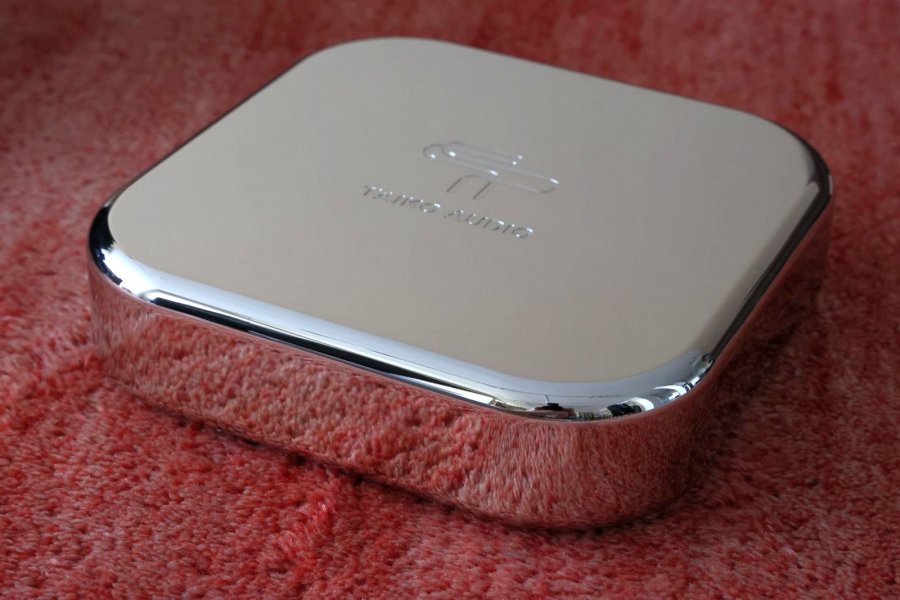
First Listening
The starting position is with the Switch with its own copper feet on top of a double-layer MDF panel that sits via steel couplers directly on the bottom section of an Artesania Exoteryc rack. This is a non-standard method that I employ because the rack’s normal bottom level position sounds too mellow and rounded for me, due to the rack’s rack-in-a-rack pendulum function. The MDF panel is in no way ideal but in my opinion much better than the rack’s standard bottom level position. In any case, with some exceptions, I normally do not use this position for critical listening.
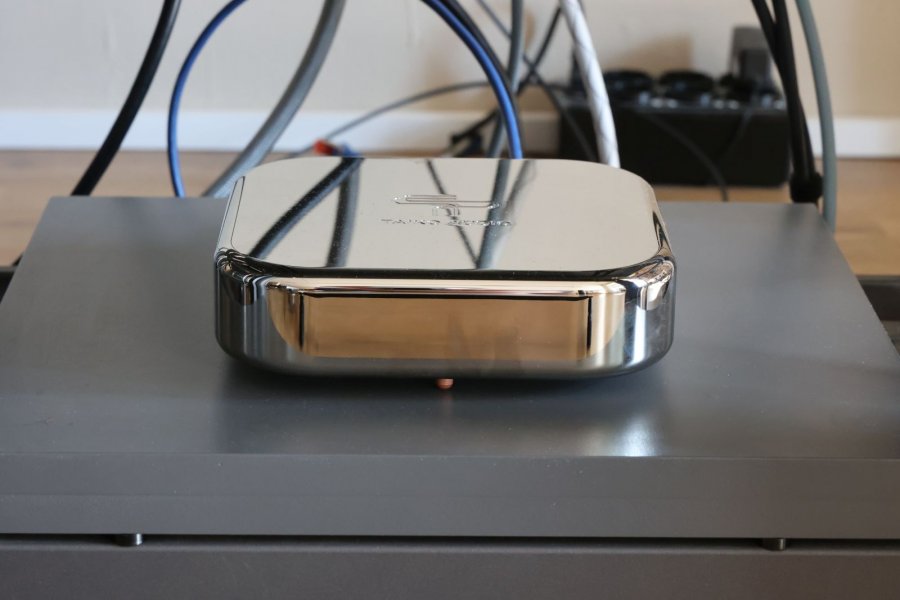
As the tests proceed, I will also position the Switch on an AG Lifter Apollo Amp Stand and an Artesania Aire platform with Carbon linear Arms and KSH2 Krion shelf. Using these support products, I will assess a range of footers to further test the influence on the Switch.
I performed the tests together with audio buddy Wouter who can be considered a sensible audiophile. He accepts that not everything we hear can be explained and he hears most things I hear, but sometimes, a difference that I perceive can be below his threshold. Well, not when it comes to the Extreme NIC and Switch. This was, quite literally, night and day.
After switching from the server all by itself using the standard UTP input, to the server connected via Extreme Switch, DAC Cable, and NIC, we both shouted primal exclamations along the lines of “Whaaaat???”
The difference was simply out of this world, as the soundstage became meters deeper as well as wider and more enveloping. The music with the Switch is somehow less matter-of-fact and much more magical, with deeper tonal saturation and a certain restraint replaced by a mesmerizing sense of free-breathing. I wouldn’t say the bass is deeper or more powerful but it is presented differently, now richer and lusher, pleasant but relatively slightly fat but still upbeat, in contrast to the native server’s relatively leaner, dryer, and arguably more staccato manner. But irrespective of the individual sonic clues, most of all, it’s the much more organic nature of the sound that makes for an immediate emotional connection and the desire to keep listening.
We’ve switched back between normal UTP (the LAN 1 RJ45 motherboard port) and the Switch with DAC cable and every time, the difference remained fascinating. Before hearing the Switch, the server by itself always sounded really great but after hearing it with the Switch, it sounds comparatively desaturated, dull, flat, and overall, just less involving.
Multiple XDMS App Control and the importance of removing the UTP cable
By the way, even if XDMS can in principle be controlled with two tablets connected to the same IP Address simultaneously, it is important to note that the server sounds better when controlled with only one active app.
Even more importantly, when using the Extreme Switch and Extreme NIC connected via a DAC cable, you really need to remove the UTP cable from the Extreme’s LAN 1 RJ45 UTP network port (part of the standard motherboard ports) if you want to hear the combo at its best.
The Extreme’s standard motherboard LAN 1 UTP network port and the Extreme Network Card's SFP port have different MAC Addresses and thus will be assigned different IP Addresses by the router. This means that the user has to find out the new IP Address (for instance using the FING app for iPad) and enter it in XDMS. After that, the “old” motherboard UTP port can still be accessed by entering its corresponding IP Address. What’s more, the two ports can even be used concurrently when using two XDMS app instances on two tablets or control points connected to the respective IP Address. However, this is not recommended for stability, and much more importantly, the DAC connection will be compromised as long as the UTP cable is still connected.
With the UTP cable still in place, the sound via the DAC connection is more diffuse, less spacious, less magical, and honestly muddled in comparison to when only the DAC cable is connected.
AG Lifter Apollo
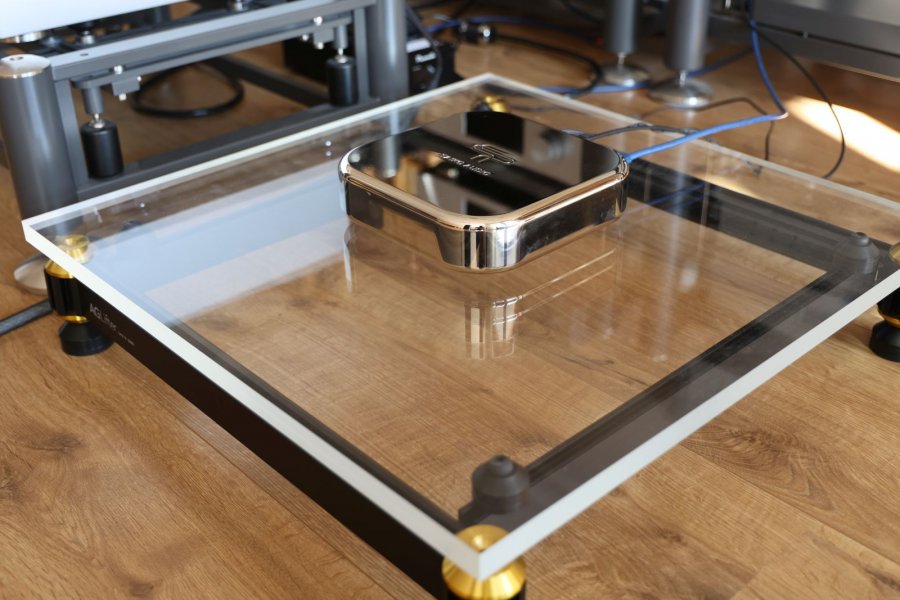
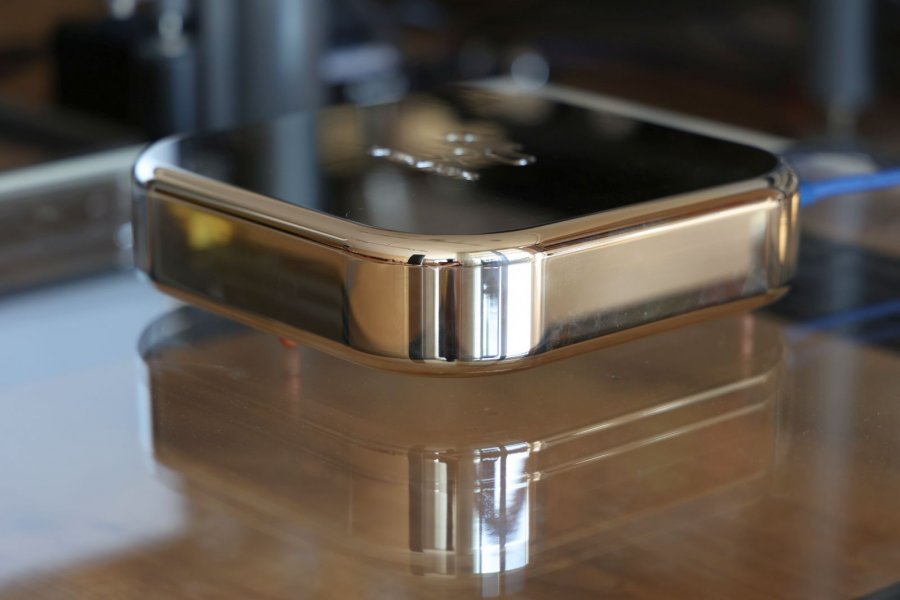
Yes, we may be talking about a network switch, but as incredible as it may sound, as I was about to hear, the supporting surface clearly has a large influence on the sound. It's really best to think of the unit in the same was as any other audio component. Moving the Switch to the AG Lifter Apollo Amp Stand (which sounds very similar to the Apollo Rack), the bass becomes very noticeably bigger and fuller, the midrange becomes warmer and more laidback, and the treble smoother and less explicit. Actually, the entire presentation moved from “Analytically Revealing” to “Musically Pleasing” with lower apparent resolution and a less spacious and ethereal delivery replaced with a more rooted and earthy delivery. Other experiments unveiled that a large portion of this rack’s sonic signature is dictated by the use of the 2.0 cm thick Acrylic panel which adds warmth, creaminess, and an overall relaxed fulness.
AG Lifter Dulcet 20 Isolation Feet
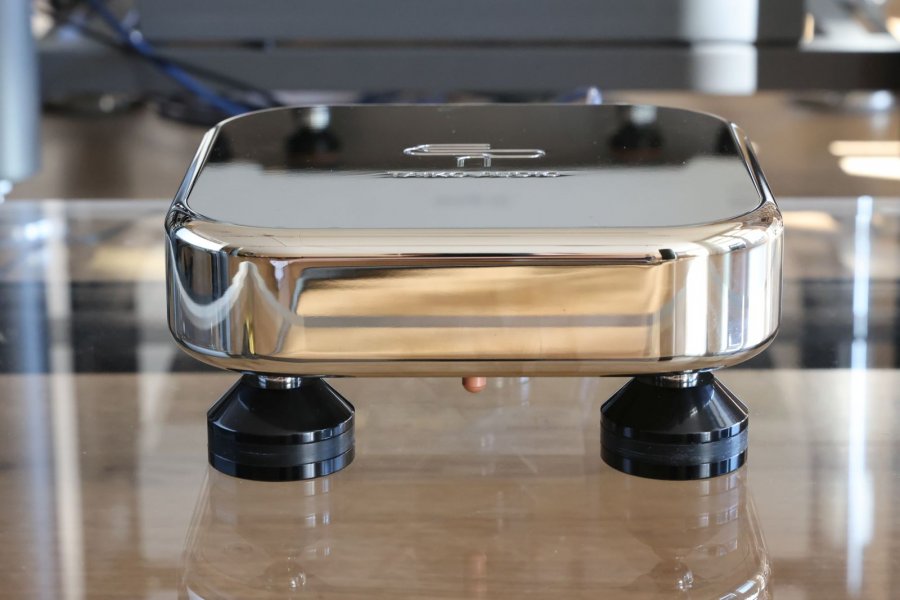
Using a trio of AG Lifter Dulcet 20 feet, the same as are used as floor interfaces, the bass becomes considerably tighter, the midrange more open and livelier, and the music as a whole more expressive, if not as airy and refined as on the MDF platform on the Exoteryc rack.
Ansuz Darkz T2S footers
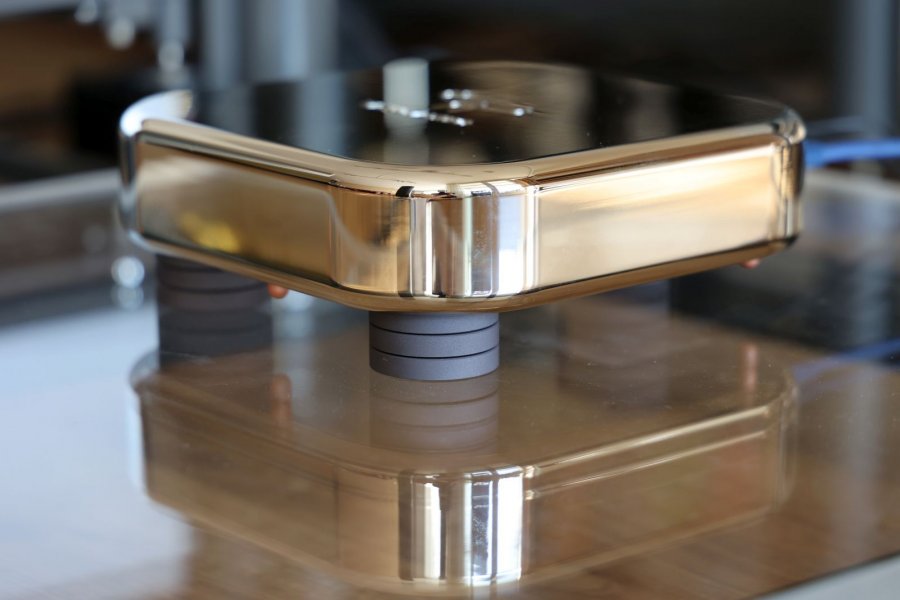
Ansuz has a range of footers among which are much more affordable models that offer great value for money but if money is not too tight, the T2S Darkz are simply the best. And, to be honest, Taiko equipment deserves the best. With a trio of Darkz T2S, the sound becomes faster, cleaner, more articulate, more transparent, and more refined, while retaining the inherent fulness and warmth of the Apollo platform. The combined sonic delivery at this point remains on the musical and “pleasant” side, more earthy than ethereal and quite detailed and expressive, but not very analytical and leaning more toward a forgiving, sweet, and easy to listen to performance. With this in mind, I did not carry out additional experiments with the compliant feet that I have at hand. With this rack/platform, hard coupling seems to sound best.
StillPoints Ultra SS V2
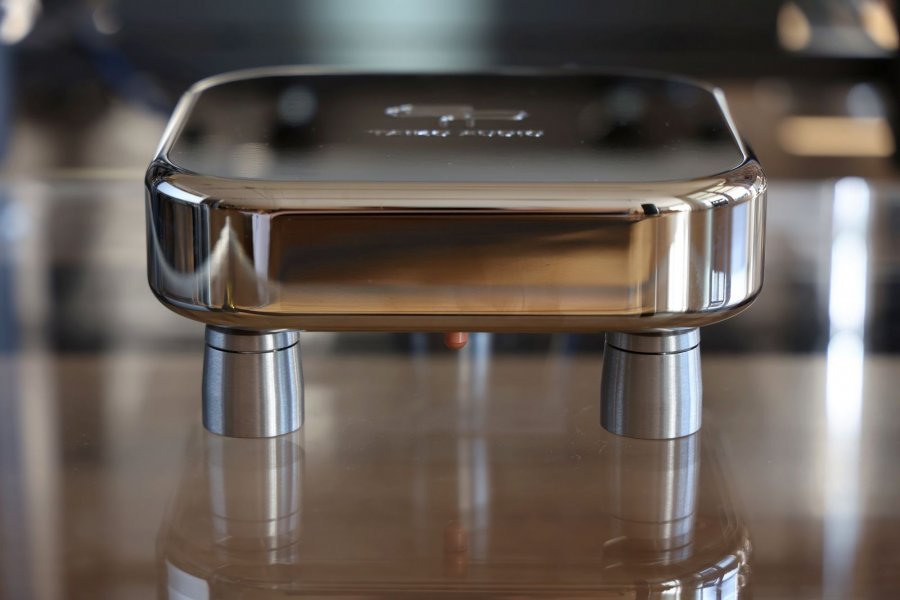
StillPoints are one of the most impactful footers I have used and depending on the use case, they can be strong medicine. In this case, they allow the Switch even more control and crisp tightness with more explicit treble but with diminished magic, and with less refinement, the sound now becomes more down to earth.
Artesania Aire with Carbon linear Arms and KSH2 Krion shelf
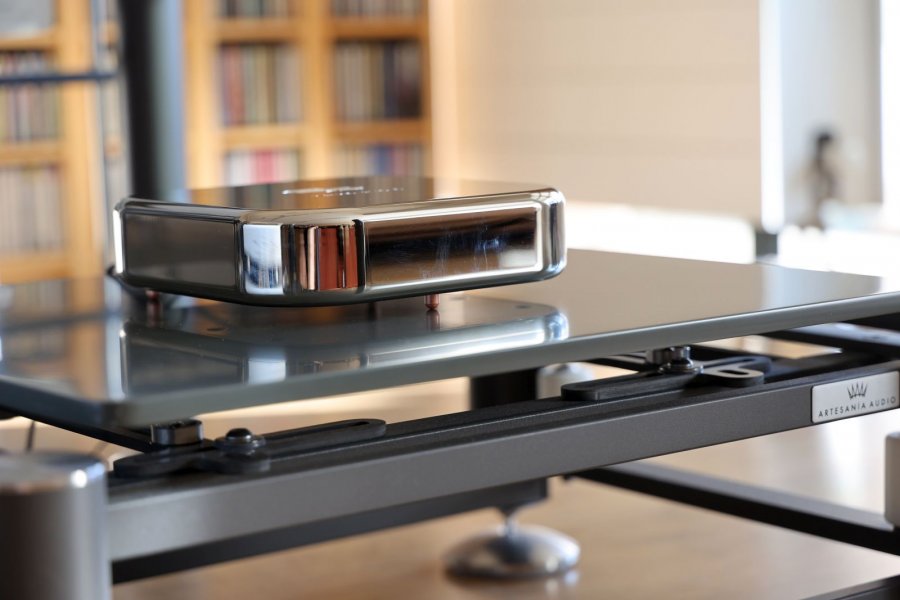
Moving from the AG Lifter to the Artesania Aire platform, and back on its own copper feet, the Extreme Switch provides a significantly airier, opener, more expressive, airier, and more transparent rendition of the music. It’s every bit as magical again as it was on the MDF shelf but with massively increased articulation, expression, and communication.
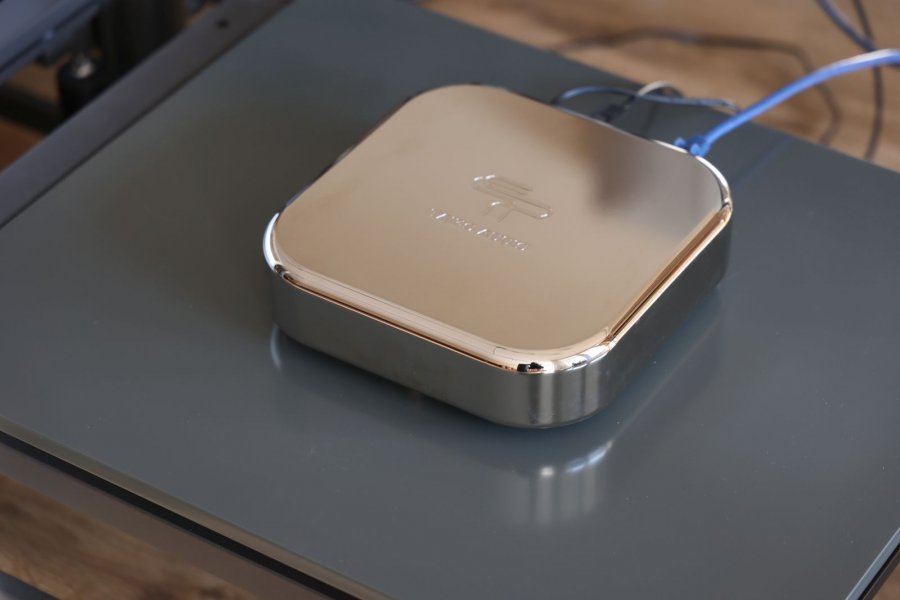
The bass is now arguably less “big” and the midrange less creamy, but the combined presentation seems timbrally more acoustic and convincing, and more realistic to me. YMMV, as I know that in some systems, the KSH2 shelf can be perceived as being lean or forward sounding. The Exoteryc and Aire racks themselves, though, possess a very organic nature.
Ansuz T2S Darkz
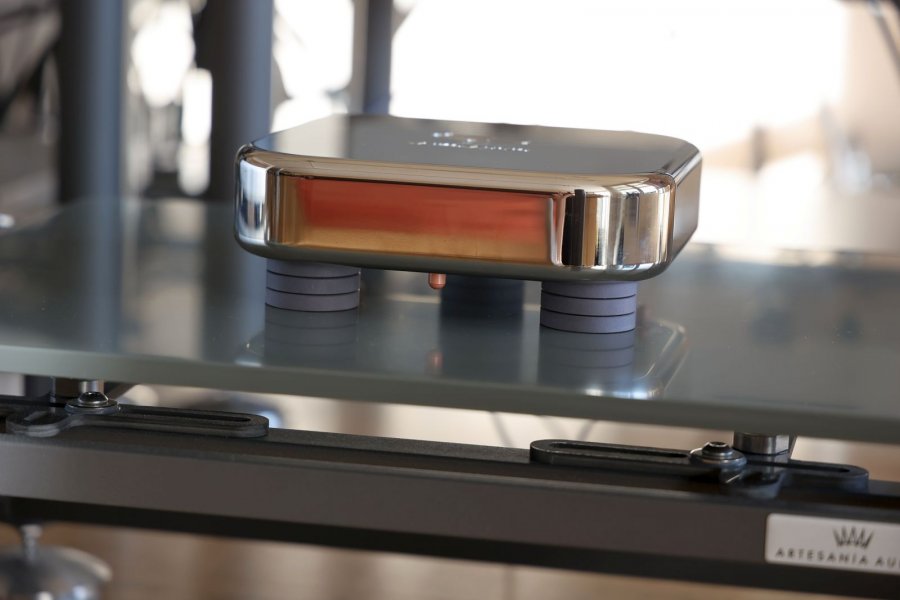
On the Artesania platform and with the Switch’s own feet, it was already insanely good but now it’s getting positively silly! The T2S Darkz manage even more spaciousness and even more magic along with silkier, more refined, and airier treble. This was the very best I’ve heard the Switch perform so far!
The review continues in the next post...
Last edited:
Christiaan Punter
Well-Known Member
Taiko Audio Extreme Network Switch and Extreme Network Card Review
Plus additional tests with various Supports and Footers
(PART 2)
Soft/Compliant Couplers
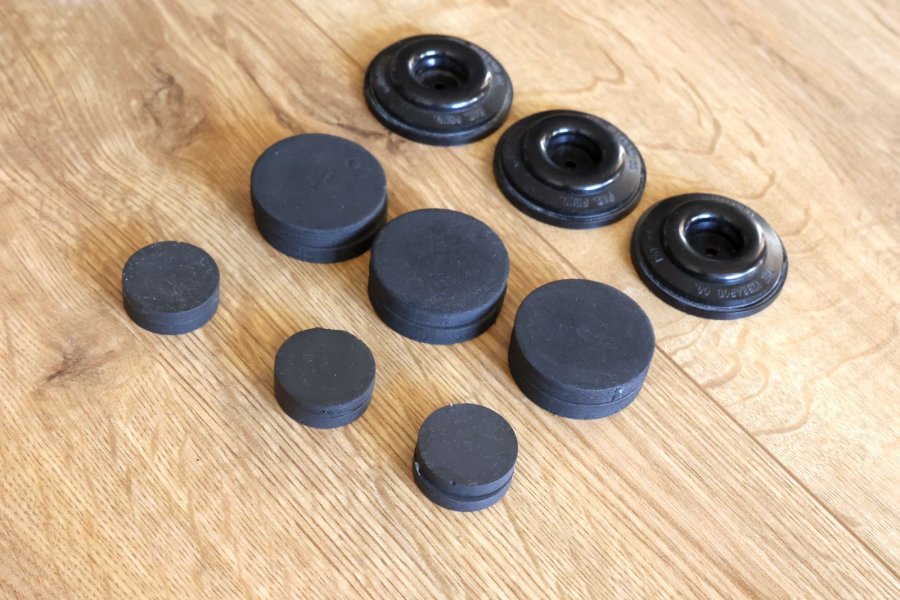
Just to see what will happen and to register more data points for future reference, I also tried a range of soft-coupling compliant feet, as opposed to the hard couplers used up to this point.
Neoprene Pads
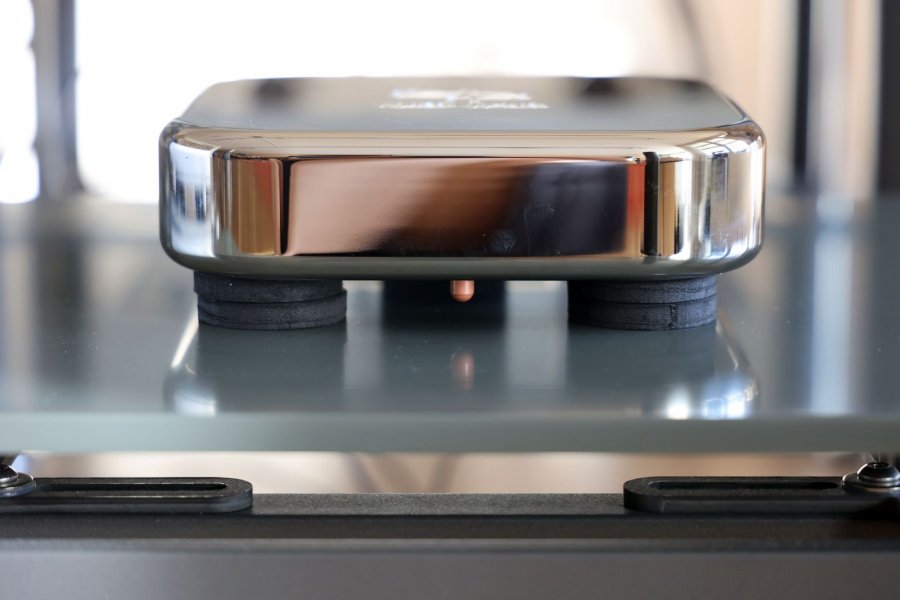
First up are three stacks of two Neoprene pads (hard synthetic rubber) that are normally supplied with Artesania racks as one of 3 possible interfaces to choose between when using their racks. Such pads can sometimes also be found under equipment feet.
As anticipated, these pads are no improvement. The bass becomes “zoomy”, fatter and thicker but the overall sound is messier and more diffuse but does not become more fluid in the process and the overall result is just a little dull, clearly no improvement over the standard copper feet.
Sorbothane pads
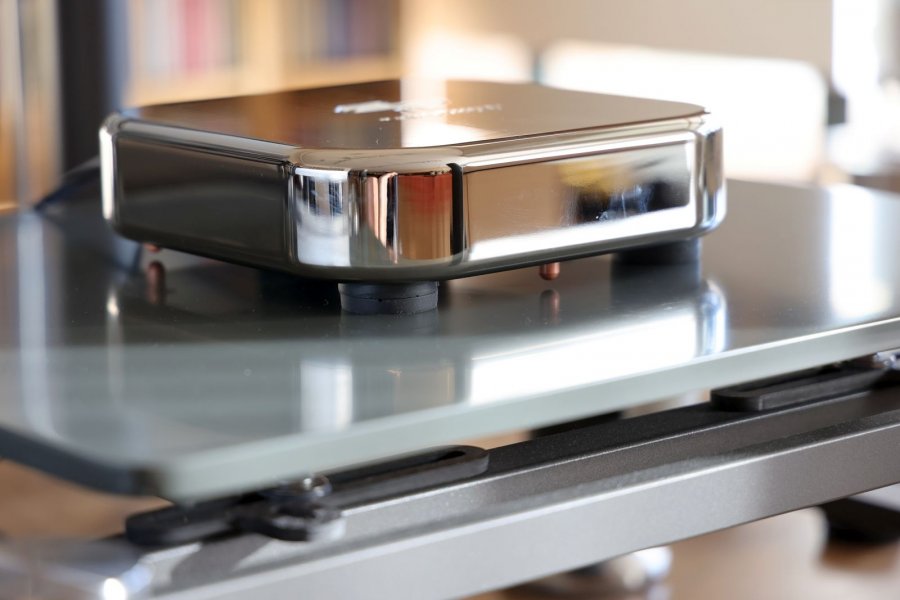
Next up are three stacks of two Sorbothane pads, the super-compliant, sometimes even sticky, pads that came with classic Jeff Rowland equipment. Similar pads can be found on the bottom of IsoAcoustics feet.
Surprisingly, these ultra-soft feet provide much clearer and more well-defined bass with no booming or zooming and actually increased definition compared to the Neoprene pads. Dynamically a little comparted, the sound is not as expressive or lively as with the Switch’s own copper feet or any of the other hard couplers but there’s a very seductive refinement and alluring free-flowing quality with lots of magic to suck the listener into the music. Unexpectedly, not bad at all!
VibraPods
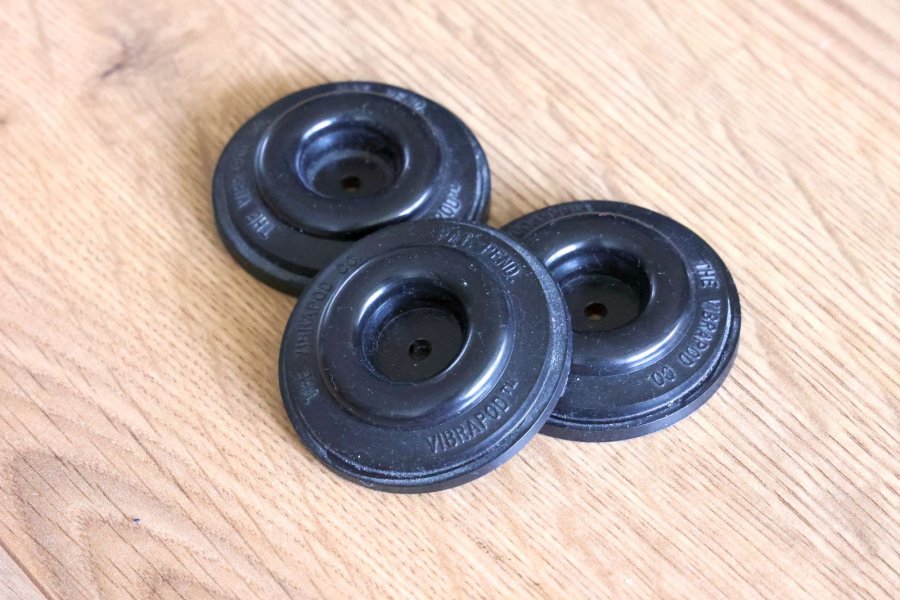
Remember these? They were all the rage in the nineties as cheap but effective tweaks. Again, given prior experience, I did not expect much, but the VibraPods were far from bad under the Extreme Switch. The bass further tightened up and the midrange became more defined and expressive but the treble becomes less refined and the level of magic is somewhat reduced. Overall, not the best I think, but still surprisingly ok and may be usable in certain circumstances.
Back to standard Copper feet
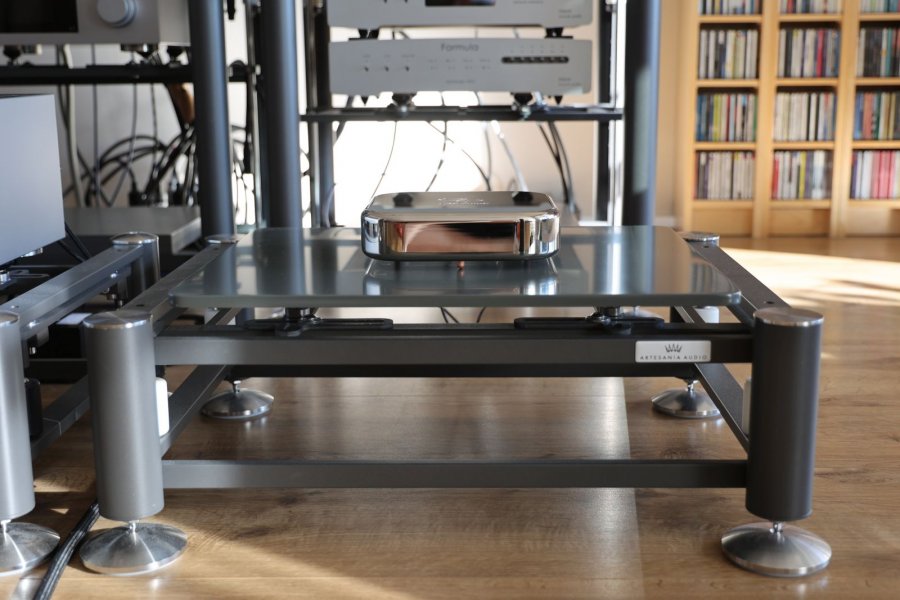
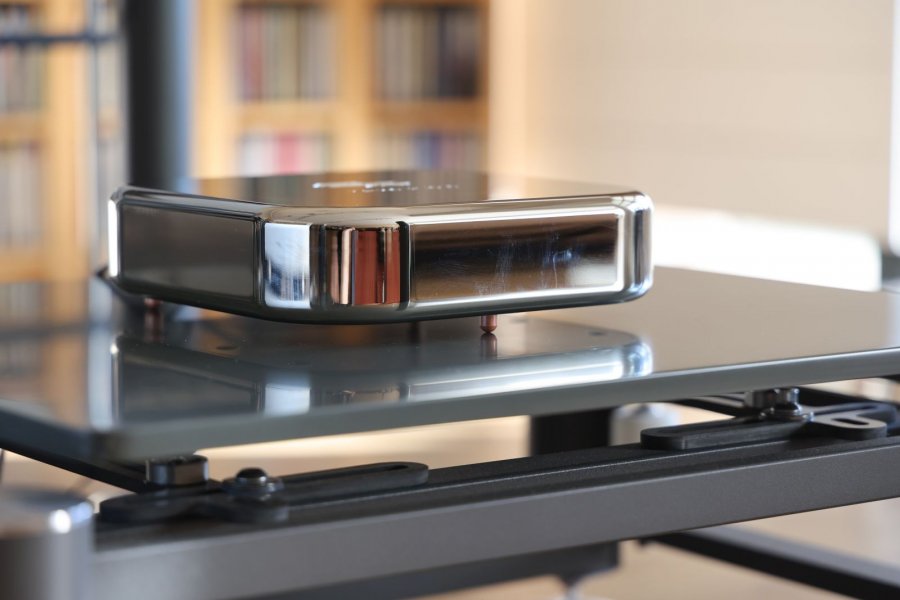
Finally, going back to the Switch’s own copper feet, the sound is remarkably robust and ballsy with a powerful lower midrange and great expression albeit less airy and refined than with the compliant feet, or indeed the Darkz feet. Compared with the latter, the standard copper feet provide a less spacious acoustic and an overall slightly boomy or bombastic character, but overall, I have to say the standard feet are well-chosen as a starting point that I suspect will work well with a wide range of support materials.
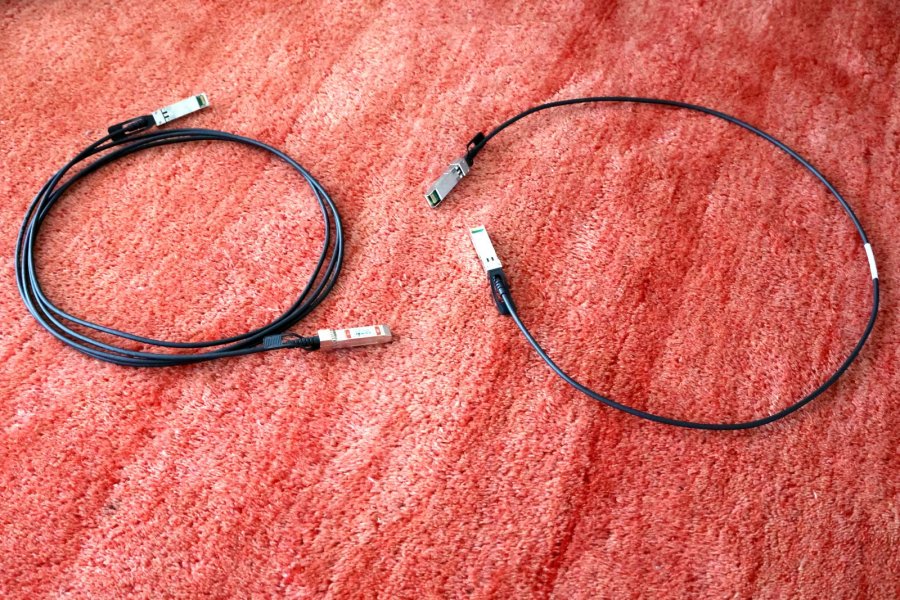
DAC Cable Length
With the Extreme Switch, I requested a 1-meter cable and a 3-meter cable. Mostly, to allow the freedom of positioning in various review setups, but secondarily, this allows a comparison between the two. These two cables are both standard models that can be purchased from the Taiko site. They have the same outer diameter and presumably have the same materials, construction, and conductor size internally (happy to be corrected, though).
Ok, so, is there a sonic difference between the two? Well, I do indeed hear a difference, but it is very subtle. What I hear is that the bass is slightly tighter and more articulate with the 1-meter cable and slightly fuller and rounder with the 3-meter cable. But again, these differences are very subtle and infinitely smaller than the differences observed between the various feet.
Remember I mentioned that my friend Wouter is less susceptible to very small differences? Well, this is one such case where he could not tell the difference between the short and the long cable, not even when I explained what to listen for. And I will admit that I may not notice it when someone would switch cables behind my back between two listening sessions. As such, I would say this aspect can safely be ignored by most, or kept in mind for those who are as obstinately obsessive as I am.
More to come
As I get my hands on more supports, racks, and feet, I will keep experimenting with the Switch and I will report my findings. For instance, I will be receiving a Callas Audio Bamboo + Carbon Fiber Soundboard in the near future and I will be most interested to hear how the Switch will perform with that as a support. Likewise, I will add my experiences with the DC Distributor and the Router if and when I receive them. Meanwhile, I wish everyone happy listening. These are good times to be an audiophile!
Last edited:
Isolation can be an interesting topic, and Christiaan I couldn't agree more with your comment "these are good times to be an audiophile". Back to isolation, the substrate in your house or apartment has a lot to do with this. Ideally a 6" poured slab would be the ticket. With My situation the floor joists are 2" X 12", 16" on center. On top of the joists sits 3/4" sheeting. On top of the sheeting is 3/4" pine tongue and groove. Insolation between the joists along with bracing of the joists. All of this sits on concrete columns along with block/ brick foundation. The point I am attempting to make is isolation can be less finnicky in certain situations. If the audio platform or rack sits on a substrate that is susceptible to vibration different isolation applications will have different results...After thought: The best substrate you can possibly have won't matter if your components sit on a cardboard box...
Last edited:
Christiaan, thank you for the effort to test and present your findings to the community.Even more importantly, when using the Extreme Switch and Extreme NIC connected via a DAC cable, you really need to remove the UTP cable from the Extreme’s motherboard port if you want to hear the combo at its best.
Regarding the UTP cable/motherboard comments, can you or Team Taiko provide any additional guidance, refinement or direction to this concept? I am not clear on the details; perhaps a pic would help? Thanks again!
Christiaan Punter
Well-Known Member
Hi Markus,Christiaan, thank you for the effort to test and present your findings to the community.
Regarding the UTP cable/motherboard comments, can you or Team Taiko provide any additional guidance, refinement or direction to this concept? I am not clear on the details; perhaps a pic would help? Thanks again!
The Extreme in its basic form has 2 UTP ports called LAN 1 and LAN 2. These are the Motherboard UTP ports. When adding the Extreme Network Card (the NIC), you add an SFP+port that can take a DAC cable or an adapter (for instance RJ45 or Fiber Optical).
With the Extreme Network Card installed, you now have the option to connect to the network via two instances: the old (mobo) LAN port or the Extreme SFP port (via the Extreme Switch).
Similar threads
- Replies
- 199
- Views
- 28K
- Replies
- 251
- Views
- 31K
| Steve Williams Site Founder | Site Owner | Administrator | Ron Resnick Site Owner | Administrator | Julian (The Fixer) Website Build | Marketing Managersing |











